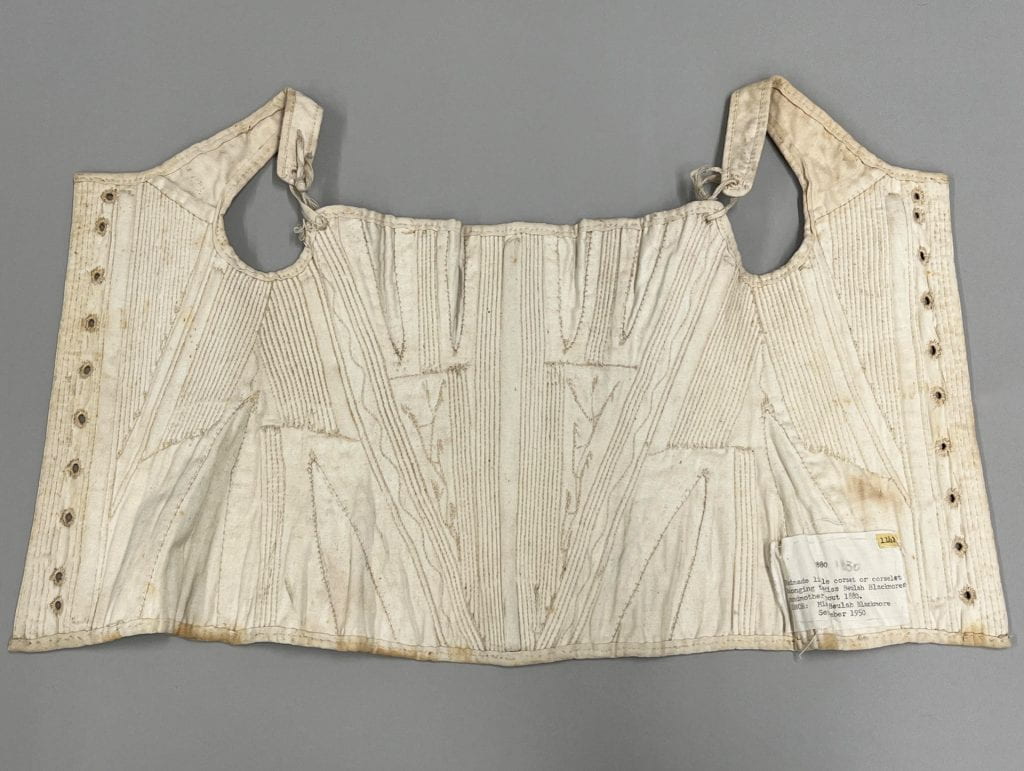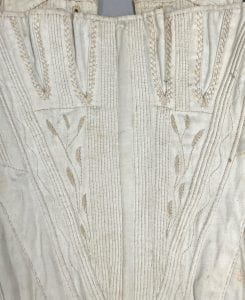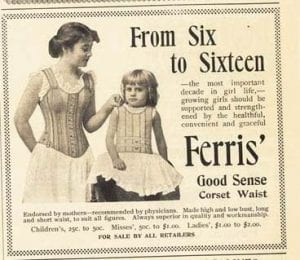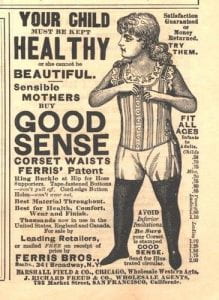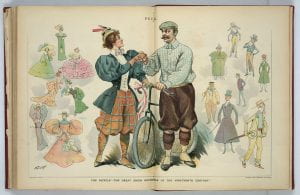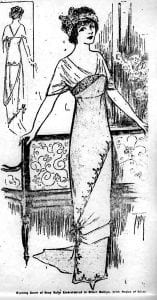This online blog post features materials protected by the Fair Use guidelines of Section 107 of the US Copyright Act. All rights reserved to the copyright owners.
Blog post by Alexis Aberman
Corsets have long been a component of women’s underwear. The first corset was invented as early as the 1500s, and included rigid materials known as “whalebone bodies” in order to externally shape and structure the female body. From that point onward, the corset became a staple in fashion history, with only a short absence in the late 1700s during the French Revolution. By the 1800s, the corset was popularized again, as small waists were again desirable and in fashion (Fine Arts Museums of San Francisco, 2016).
This hand stitched child’s corset from the Cornell Fashion + Textile Collection (Accession Number 1141) (Figure 1) provides a glimpse into the past, aesthetically and socially. This garment was produced between 1825 and 1835, and the corset was intended to be worn as an undergarment. It has been intricately hand-stitched and embroidered with leaf motifs (Figure 2). This garment includes bussets for the bust and hips; this 19th century feature of the longer corset allowed the breasts and hips more freedom, while restricting the waistline (Fine Arts Museums of San Francisco, 2016). This corset is soft and does not include boning, made entirely of cotton sateen; however, the eyelets along the back of the corset are indicative of the fact that it could be tightly laced. Consequently, the waist could be cinched to become smaller to create the illusion of bust and hips, which pre-pubescent girls would not have yet developed. Therefore, the corset serves to shape the body to conform to the hourglass figure that was socially accepted as the ideal, fashionable silhouette.
This specific corset is unique in that it was produced for a child. We must imagine a society in which it was acceptable— and even encouraged— to shape and restrict young girls’ bodies in such a way. Children are not fully developed; thus, the corset serves to shape the body to create breasts and wide hips, which girls likely had even developed yet. Nonetheless, childhood corsetry was commonly practiced in the 19th century, as mothers imposed this womanly expectation on their daughters. Some mothers believed that starting the practice of corsetry on young girls would allow them to develop into an ideal shape and become more accustomed to the garment by adopting it earlier. In The Queen, an English periodical, one mother wrote “…the formation of the waist is not begun early enough. The consequence of this is, that the waist has to be compressed into a slender shape after it has been allowed to swell, and the stays are therefore made so as to allow of being laced tighter and tighter” (Lord & Shep, 1993). This quote suggests that child corsets could be used to inhibit the growth and development of the female body in ways that were not accepted as attractive. Furthermore, it is clear that women felt pressured to achieve the ideal body shape themselves, and this pressure was projected onto their children. In fact, some women (as evidenced by this quote) believed that beginning to shape the body sooner would yield the best results— a practice they likely believed would best serve their daughters in the future. Thus, the perpetuation of unnatural body standards were passed from generation to generation.
The belief that children should be corseted was bolstered by the media. Late 19th century / early 20th century advertisements (see Figures 3 and 4) demonstrate how women were urged to dress their young daughters in corsets. These advertisements by Ferris’ Good Sense demonstrate how corsets were advertised to be associated with both health and beauty. These corsets were intended for children aged “six to sixteen” and the brand claimed “growing girls should be supported and strengthened by the healthful, convenient and graceful Ferris’ Good Sense Corset Waist.” These advertisements play off mothers’ social anxieties that their children may not be perceived as beautiful, in order to successfully sell their product. The anxieties people face surrounding the pressure to be beautiful and thin still exists today, even though corsets are not nearly as widely worn in modern society.
In addition to the negative psychological impact of aiming to achieve body standards which are extreme and difficult to attain, there were also medical concerns about regularly wearing corsets. Achieving the hourglass figure coveted by so many women led to restricted breathing, poor digestion, and atrophy of the back muscles. Rib cages could become physically deformed by the long-term use of corsets and tight lacing, as demonstrated by Figure 5 (Isaac, 2019).
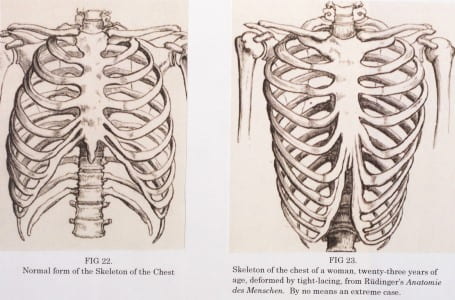
Figure 5. Rib cages could become physically deformed by the long-term use of corsets and tight lacing. (Isaac, 2019)
Given the potential for harm and the controversial nature of the corset, some women became involved in the dress reform movement in the 19th century in hopes of eradicating the widespread use of restrictive garments. In the 1850s, for example, Amelia Bloomer advocated for Bloomer style pants (Figure 6) beneath dresses; this practice would allow women to have more freedom of movement and the ability to participate in more physical activities, such as riding bicycles (Campbell, 2019).
Although this initial movement was not successful, the early 20th century brought about the return to the looser Empire silhouette, which eliminated the need for corsets. Paul Poiret introduced the hobble skirt during this time, which was ironically restrictive of the legs, despite freeing the upper body of the corset (Figure 7). Poiret wrote in his autobiography, “It was in the name of Liberty that I proclaimed the fall of the corset and the adoption of the brassiere, which since then, has won the day. Yes, I freed the bust, but I shackled the legs” (Poiret, 1931). Thus, even the movement towards greater freedom involved restriction.
Overall, one is left to reflect on the restrictive trends of past fashion in the context of the present day. Today, more women enjoy the freedom to choose what they wear. Corsets (while still available) are far less restrictive and less commonly worn compared with past generations. Furthermore, the practice of corsetting children has long ceased. However, reflecting on the restrictive practices of the past can help us increase our vigilance of restrictive practices moving forward. While we might not physically alter children’s bodies through dress today, we still impose societal norms on them by dressing them in accordance with social expectations. Young girls are often clothed in feminine dresses and pink bows, while boys are more often clothed in pants and masculine-colored garments. Thus, we might be restricting children in other ways, and this is important to keep in mind as we create our own families and raise our own children. As a society, we can only aim to move forward in aims to create a more free and accepting world.
Alexis Aberman is a senior in the College of Human Ecology majoring in Human Development and minoring in English.
References
Fine Arts Museums of San Francisco. (2016, March 29). Corsets in Context: A History. Retrieved from https://www.famsf.org/blog/corsets-context-history
Campbell, A. (2019, November 05). Bicycles, Bloomers, and the Vote: Dress Reform. Retrieved from https://blogs.loc.gov/teachers/2019/11/bicycles-bloomers-and-the-vote-dress-reform/
Huckins, M. (2020, December 16). Children in Corsets? Retrieved from https://victorianvisualculture.blog/2020/12/15/children-in-corsets/
Isaac, S. (2019, May 13). The dangers of tight lacing: The effects of the corset. Retrieved from https://www.rcseng.ac.uk/library-and-publications/library/blog/effects-of-the-corset/
Lord, W. B., & Shep, R. L. (1993). Freaks of fashion: The corset & the crinoline (1868). Mendocino, CA: R.L. Shep.
Poiret, P. (1931). My first fifty years. London: Gollancz.


